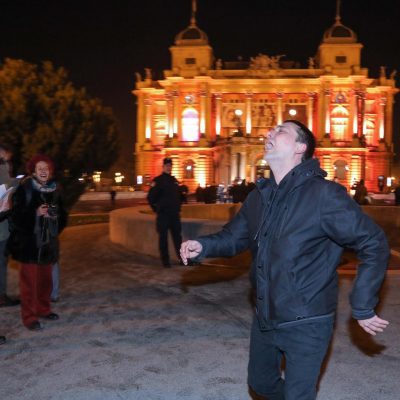

 Jose Vidal: Emergenz. Hamburg, 2019
Jose Vidal: Emergenz. Hamburg, 2019ACT and Impact
ACT stands for Art, Climate and Transition. In bringing these three words together, the people and organizations behind ACT have committed themselves to explore what art has to offer in facing the climate crises. And thus, we need to talk about impact. What can be expected of art? And what do we expect? Can art help us better articulate or understand the causes, effects, and the challenges climate change poses? Can art propose alternative ways of being in the world, can it inspire us to find our way out of the crises, or to live with them? Or should art work in different directions: voicing the pain and anger of those affected by climate change, or maybe help us mourn our climate losses? The ACT work package ‘learning to impact’, led by Jacco van Uden and Arie Lengkeek, explores these questions for the project and with the partners.
It is not always easy to talk impact in the world of art. The notion of impact is (still) often associated with the promise of being able to predict and measure specific effects – an idea many consider to be at odds with what art is and how it works. And not only art, also ecology teaches us something else about interdependence, effect and impact. What we need therefore is an intelligent, open-minded, and good-naturedly exploration of the impact of art on climate change.
Artists reflecting on impact
As part of our investigation into the place and role of impact in artistic practices we are conducting a series of interviews with artists from the ACT network. To get an in-depth understanding of how artists and art collectives themselves deal with questions concerning the impact of their work, we talk to them about their artistic practices and their considerations to work, or don’t work, with impact in mind. Check this page for an overview of the interviews we have so far.
The interviews are not just interesting to learn about the (non-)place of impact in the work of specific artists. We take these interviews – 10 in total – as an opportunity to find both similarities and differences in the ways artists relate to impact. Does impact play a role in their work altogether? Is impact something that you can only discuss meaningfully in hindsight – i.e., what has been the impact of my work? Or should a work be made with impact in mind to begin with?
(Answers to questions like these are important for artists themselves. To explicitly address the place of impact is a way to critically reflect on one’s own practice and to open oneself up to exploring new artistic strategies. And finding out how other artists go about addressing climate change is of equal importance when it comes to Leaning to Impact.)
Some of the preliminary findings in comparing impact strategies of the artists:
Learning about the ‘impact strategies’ of the artists is also of great importance to the art institutes that work with these artists. In what ways and to what extent do these strategies have an influence on the curational practice or the business model of these institutes?
Institutions for impact
In November 2021 we shared the preliminary findings from the interview series with the ACT partners in Lisbon (PT). There is general agreement among the ACT partners that impact is an important phenomenon that deserves our curiosity. The art world should not shy away and focus only on the neoliberal instrumentalization of art. It can use the word to its benefit: how to create impact as an offensive strategy? Art institutes – especially the bigger ones – face the challenge of justifying investments by reporting on, most commonly, numbers of visitors. If art institutes manage to embrace wholeheartedly the notion of impact and use it pro-actively, impact offers these institutes the vocabulary to reflect on projects critically and systematically. Intelligent, sensible use of the notion of impact can be used to assess just how successful a project has been. Or, to create a strategy that aims to enlarge impact.
These strategies shift the attention to a much more precise understanding of the audiences that can be involved. It supports an approach that sees the ‘black box’ of the theatre or the ‘white cube’ of the museum as an artefact that maybe enables the production of art, but also disconnects it from those who are most affected by the issues that are raised in the safe space of the cultural sphere. ‘How to be radically open’ is a question many artists are placing at the heart of the artistic work. This demands the arts institutions to change their policies, tactics, operations as well.
Kaaitheater (Brussels, BE), for instance, recently adopted a ‘pay what you can’ model for entrance fees. As a realization of their new motto How to Be Many? they chose to achieve maximum accessibility for as many people as possible. There is a suggested price for every performance, the price that used to be the standard rate. It is up to you to decide whether this ticket price fits into your current financial situation… or not. If a lower price would make it easier for you to come to the theatre, you are welcome to select that price. Can you pay a higher ticket price? Great, that way you make it possible for others to pay less. Solidarity is a very concrete choice, that benefits many. The ‘Pay What You Can’ approach has resulted in a firm increase of first-time visitors (+32%) including the next generation (>50% visitors under the age of 35).
ecologies of change
In the coming period, the ‘Learning to Impact’ work package will take these preliminary findings further. We will delve deeper into the practices of the artists, the tactics and strategies of the arts institutions and their mutual exchange. We see the concept of impact not as a static, linear concept. Rather, we are suprised by the likeliness it has to ecological processes and the dynamics of complex systems. In the coming period we will explore these observations further, both by connecting to the academic discourse on change management and the very concrete practices that give shape and content to ACT.
january 2022

